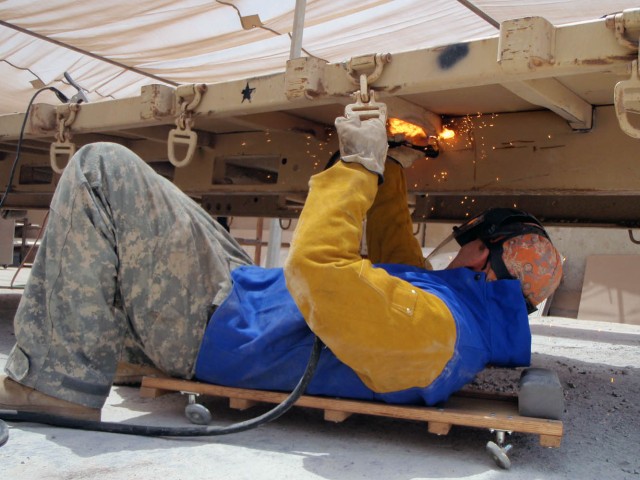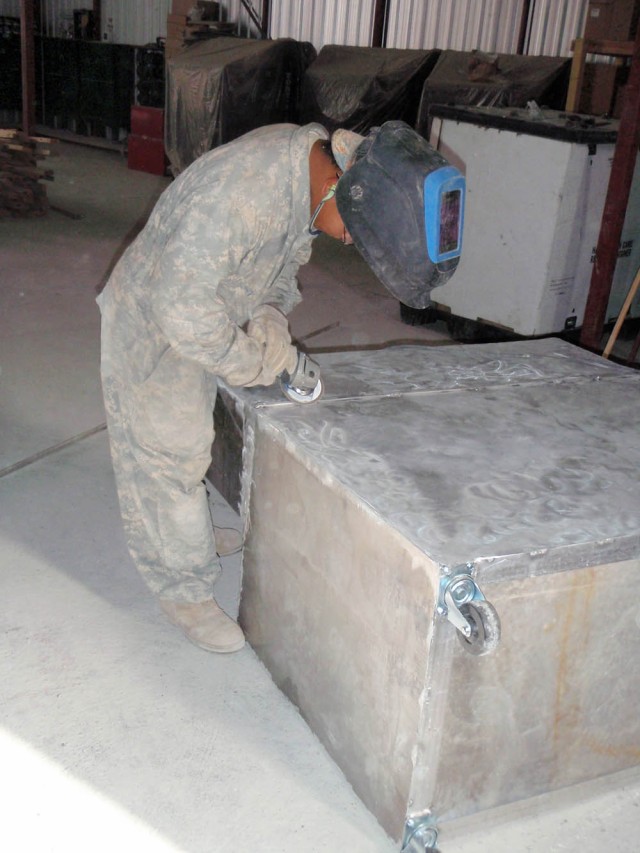BAGHDAD- Metalworkers have long been associated with Cavalry troops. In the days of mounted horse cavalry, farriers were always on hand at encampments to keep the horses shod. Blacksmiths were also necessary for making the shoes and repairing other iron and steel implements.
While you won't hear too many anvils ringing from hammer strikes or smell sulfur from blistering forges these days, the important trade has been carried on by modern welders.
Sgt. Nathan Henderson and Spc. Antonio Quebatay, welders for the 1st "Garryowen" Squadron, 7th Cavalry Regiment, 1st Brigade Combat Team, 1st Cavalry Division, have filled the role of modern-day blacksmiths and farriers, playing an integral role in the maintenance process of equipment. They spend their days cutting and welding in an effort to fix equipment quickly and properly. If a vehicle is dead lined due to damage, such as a blown radiator or a warped door hinge, the welders use up-to-date techniques to make the repair.
The methods used for making repairs are significantly different than those used in days past. Forging and shaping metals can now be accomplished with machinery. Electrically powered bench grinders are now used to wear away metal and polish rough edges. Rather than joining two separate pieces with heat and pressure from fire and hammer blows, an electrical arc welder can place metal to fill gaps without making direct contact. A variety of gases for torches, and varying alloys of steel and aluminum are used for different projects. Welding is a skill that demands both art and science.
Henderson and Quebatay aren't bound to just repairing vehicles. They use their creativity for other functional projects as well.
Sgt.1st Class Scott Wilkes, the noncommissioned officer in charge for the squadron's communication section, approached them with a new project aimed at relocating much needed communications equipment. The signal technology that powers the radios and computer networks was located outside instead of in the building.
Most of the squadron's communications equipment operated from two track vehicles parked near the tactical operations center (TOC). The equipment's location made it difficult to maintain, and vulnerable to extreme temperatures.
Wilkes had the idea to put build a cart that could house the same systems typically operated from the track vehicles. After some discussion between Henderson, Quebatay, the Squadron Signal Officer and noncommissioned officers from the communications shop, a design emerged for their "TOC-in-a box".
Henderson and Quebatay took time to make minor adjustments during the week-long process of building the cart. The squadron's radios, amplifiers, and network systems are now stored on the cart, which is located inside of the TOC. The communications equipment is easier to maintain, and protected from the elements.
The duo has proven they can make just about anything if the need arises. This tour, they have built equipment used for a variety of purposes. They built a new guidon stand for the squadron, several racks for holding body armor, helmets, and shelves used to store equipment in the maintenance yard. They even used steel drums to create a few barbecue grills. Currently they are building a rolling medical supply cart for the squadron aid station, and an extension for a communications tower designed to boost signal strength.
You might say welding is in Henderson's blood. Both his father and a brother are welders. While growing up in Globe, Ariz. his father and an older friend introduced him to welding. He continued with the trade, taking high school and college classes, and earning a number of professional certifications. Henderson even worked as a welder for several businesses, including Phelps-Dodge Mining, before joining the Army.
He has been welding for eighteen years now, seven of them as a Soldier. His experiences have taught him that you can learn from anyone. Experienced co-workers have taught him individual techniques and special tricks of the trade. However, his dad has been the greatest teacher.
Henderson's assistant, Quebatay, never welded before leaving his hometown of Honolulu, Hawaii to join the Army. He learned through 15 weeks of classes and eight-hour days in the workshop during his Advanced Individual Training at Aberdeen Proving Ground, Md. His experience since has earned him the respect and confidence of his supervisor and other leaders in the squadron.
"He comes up with some good designs," explained Henderson.
The Squadron's battle rhythm has kept both men busy. "It is fun," says Henderson. "I really enjoy the work. It's always good if you can have fun on the clock."






Social Sharing